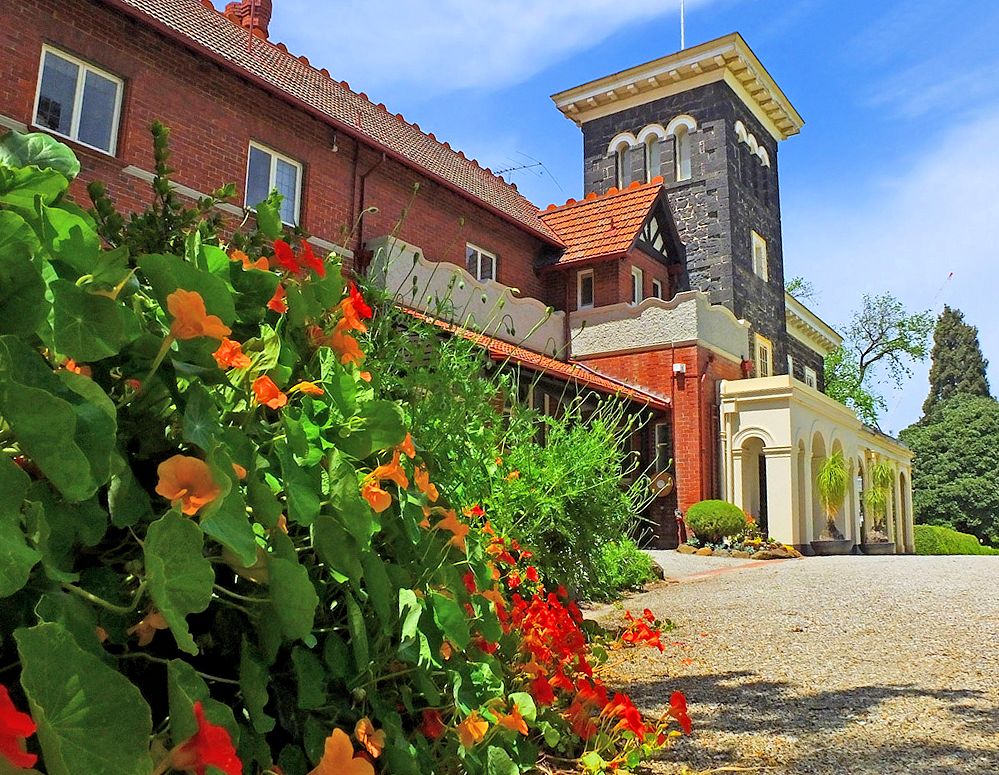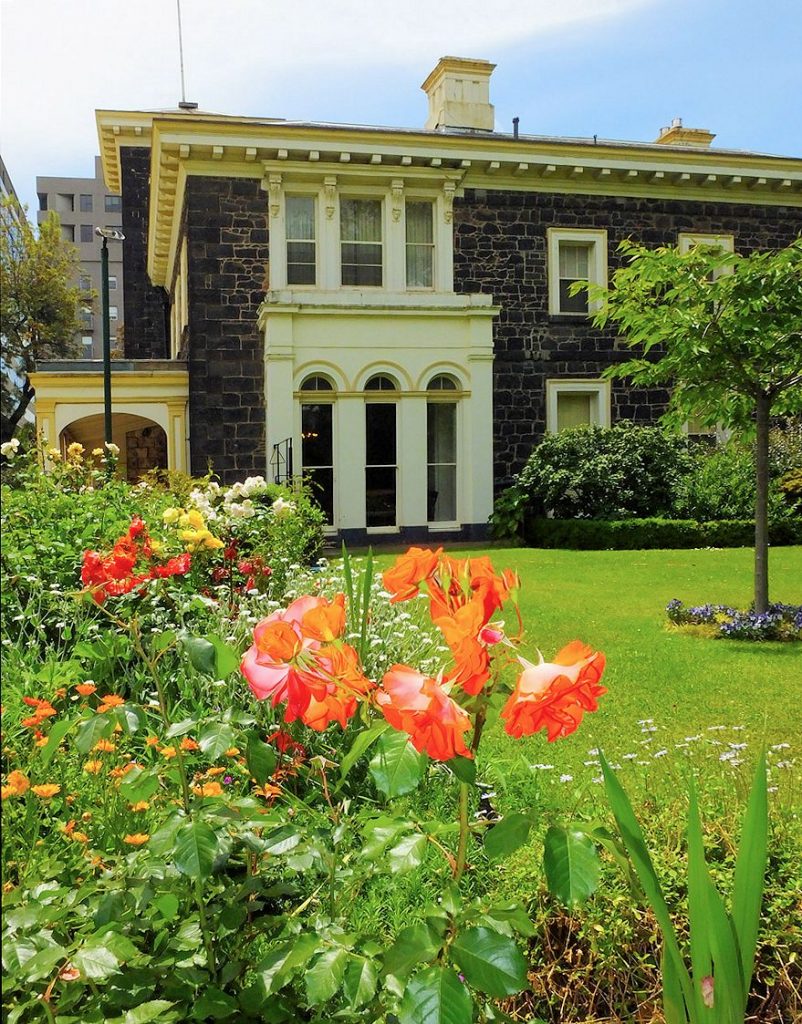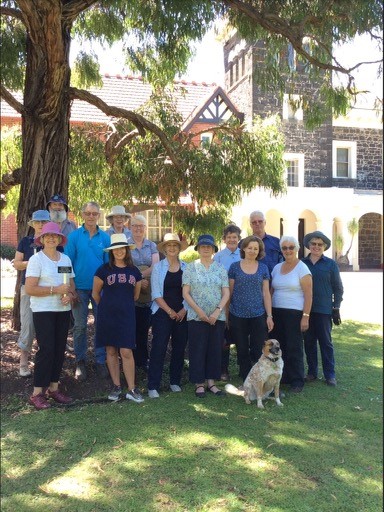Since 2001, the Bishopscourt garden has been maintained by a team of volunteers who meet once a week to carry out the many tasks required to keep a garden of this size looking its best. The volunteers come from many walks of life, with individuals contributing their different skills, but all dedicated to the maintenance of this precious heritage site as a community asset. The gardeners have become part of the Bishopscourt community, providing supporting services for events in addition to their work in the garden.
The traditional owners of the land the garden occupies are the Wurundjeri/Woiwurrung people of the Kulin Nation. In 1848, Bishop Perry, the first Bishop of Melbourne, selected this site as the location of the Bishop’s home. Its main views at the time were south across Jolimont and Richmond Paddock (later Yarra Park), to the Yarra River Flats and the Domain beyond.
Mrs Perry took a great interest in her future garden. She wrote shortly after her arrival in Melbourne in 1848: ‘Mr [La Trobe] says, as soon as we get a garden, he will set to work to get it into order for us. He is going to take our seeds, (if our garden is not forthcoming before sowing time) and appropriate a bed in his garden to them, to be called Mrs [Perry]’s bed. Is it not kind?’ Australian Sketches: The journals and letters of Frances Perry, p.71.
In 1854, architect Charles Swyer laid out the grounds. His job was made easy by the siting of the residence by Newson and Blackburn in the north-eastern corner of the property, east of an ancient river red gum (Eucalyptus camaldulensis). This eucalypt, often referred to as the Corroboree Tree, survived on the site until the 1990s. A replacement tree, a seedling of the mature river red gum on the Clarendon St fence line, has been planted in the lawn.
Walter Butler was a talented landscape architect and it is believed that during the 1903 extensions to the house he had some influence on the garden. Indeed, it was at this time that he delivered a seminal paper on landscape design to the Royal Victorian Institute of Architects which included this comment: ‘If a garden is as much a work of man’s art as his house is, it is – owing to their oneness, and inseparableness – as much the architect’s business to design the garden as to design the house.’
Resident bishops or archbishops and their families have enjoyed the garden and many have made their own contribution. Bishop James Moorhouse chose the garden to bury his faithful dog in 1884 and the headstone can still be seen with the touching inscription ‘In memory of Dear Old Tim, a friend true and tried’. Bishop Lowther Clark and his wife, who took up occupancy in 1904, are reported to have held many garden parties, as did Archbishop Harrington Lees. The tradition continued and there are numerous reports available of garden parties right up until the present day.
Archbishop Woods and his wife were both keen gardeners and lived with their family at Bishopscourt for 20 years (1957–1977). Mrs Woods planted several native trees on the eastern boundary of the southern garden and the family named this planting ‘the Deanery Screenery’ referring to the neighbouring property which was then owned by the church and the residence of the Dean of Melbourne. Archbishop Woods’ love of figs resulted in several of these trees being planted in the orchard. Archbishop Peter Watson, pursued (unsuccessfully) possum control methods and his wife Margo was tireless in watering according to restrictions of the day.
From the 1960s, garden maintenance focused on a tidy appearance and little real gardening was done. In 1998 the church lodged an application to Heritage Victoria to subdivide the land at Bishopscourt. They wished to excise the south-eastern comer of the site. The East Melbourne Group were opposed to these plans from the outset and their campaign was joined in late 1999 by the Australian Garden History Society (AGHS). Heritage Victoria disallowed the subdivision. The AGHS, through its Chair, Helen Page, offered to maintain the garden through regular working bees, and in July 2001 it commenced a program of working bees on the 3rd Wednesday of each month. Working bees now occur weekly and new volunteers of any ability and gardening experience are welcome to join.
Following years of neglect, plants had been lost and layers of rubbish, ivy and other weeds built up in the shrubberies. The working bees cleared much away and garden waste continues to be managed by separating chippable material from that suitable for composting.
Bishopscourt (house and garden) is included on the Victorian Heritage Register and 18 trees are included on the citation. Nine of the major trees are also on the City of Melbourne’s register of exceptional trees. These include two English elms (Ulmus procera), the Port Jackson fig (Ficus rubiginosa), the Italian cypress (Cupressus sempervirens), two Monterey cypresses (Cupressus macrocarpa), the river red gum (Eucalyptus camaldulensis), and two Dutch elms (Ulmus x hollandica), some of which were planted in the late 1800s.
The root zone of the Port Jackson fig (Ficus rubiginosa) was for years covered by logs and suffered from extreme stress due to soil compaction. The wood heap was relocated to enable the tree to receive attention; it responded well and has been added to the National Trust’s Significant Tree Register. In 2002 a number of brick paths with spoon drains were rediscovered under the fig. These paths are important elements of the garden’s path network although they are currently covered with gravel.
Heritage Victoria funding enabled the driveway and some garden paths to be resurfaced, the pergola to be reconstructed and four Ulmus x hollandica (Dutch elm), an Agathis robusta, a Robinia pseudoacacia and a Magnolia grandiflora to be replaced. Donations received from events and tours of the house and garden enable ongoing maintenance of the garden. Beehives sponsored by local organisations have been located in the vegetable garden, improving pollination throughout the garden.
Bishopscourt continues to present challenges including water restrictions, elm suckers, possums, rats and weeds, particularly acanthus, ivy, tradescantia and oxalis.
In 2011 an underground brick cistern (approx. 20,000 litres) – originally the house water supply – was rediscovered and cleaned. The old hand pump, buried under the accumulated silt, has been rebuilt. The cistern and a new tank installed under the front lawn and filled by rainwater from the house roof, have been integrated into a capture and watering scheme for the garden – made possible through the support of the Vera Moore Foundation.
Over the last 15 years there have been a number of supporters of the garden and all donations and assistance are gratefully received. The goal is for the garden to be financially self-sustaining.
For volunteering, contact Bishopscourt.








